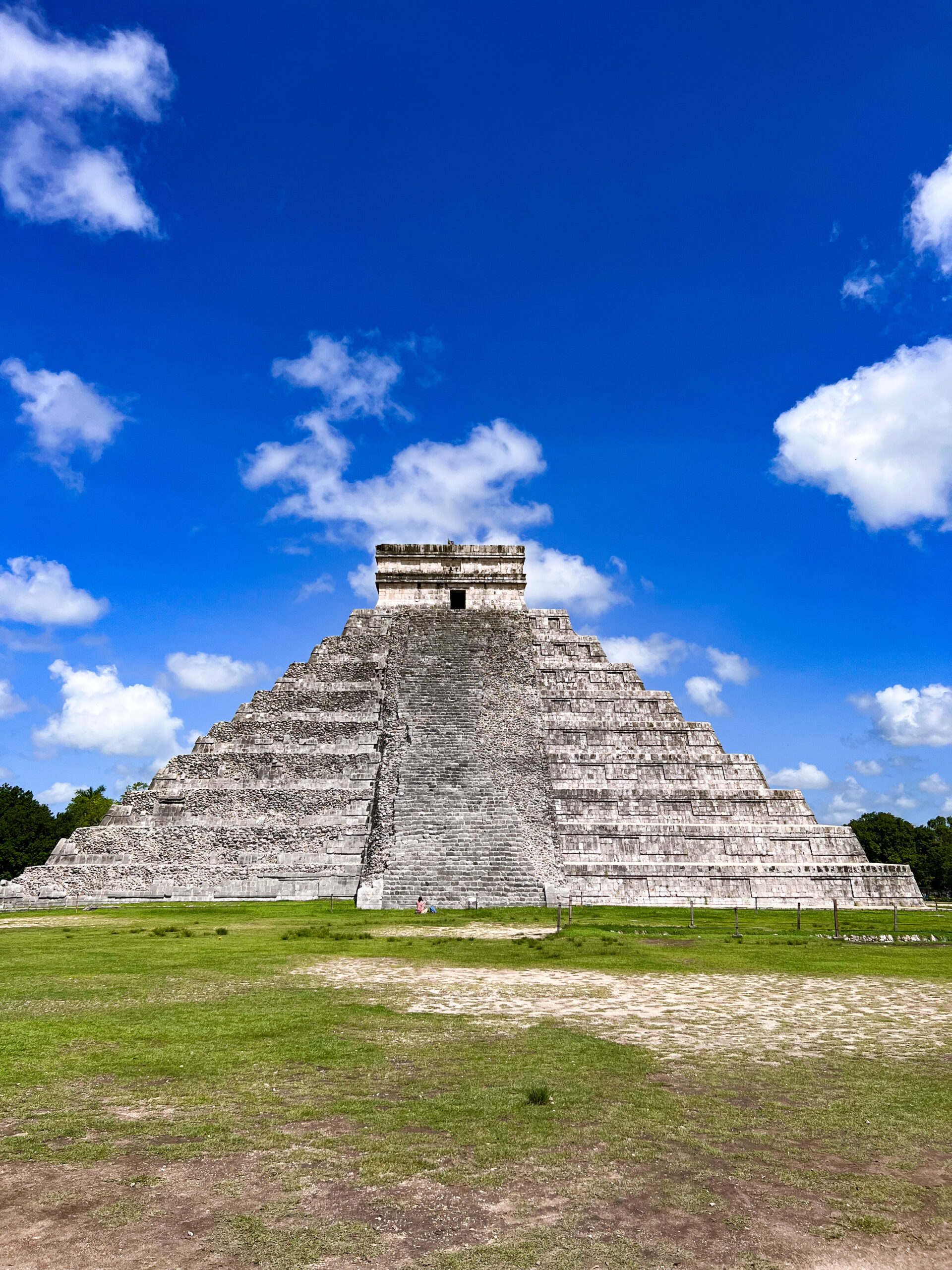Chichén Itzá is the most famous Mayan ruin, a UNESCO World Heritage Site and also one of the ‘Seven Wonders of the New World’. Located on the Yucatan Peninsula, the city had its heyday in the 9th and 10th century but its ruins give us some fascinating insights into the Mayan peoples and culture. Practically every tourist to Mexico heads to this ruin, as a result it gets incredibly busy. If you take only one thing from this blog, my tip would be to get there first thing in the morning, when the site opens at 8am, to avoid the crowds.
That is exactly what I did. I took a shuttle from Valladolid (an hour-long journey) and we arrived before the ticket offices opened. In fact, the vendors were setting up as we began wandering around the site. It felt like we had the place to ourselves for the first couple of hours. By the time I left in the early afternoon, I was more than ready to escape the heat of the scorching sun and the throngs of visitors; both took away somewhat from the magic of the place.

Chichén Itzá in the Mayan tongue means ‘at the mouth of the well of the Itzá’. The Itzá were an ethnic group of Mayan heritage and it is thought that the ‘well’ refers to the underground rivers beneath the site that served as the main source of water for the city. One of the surprising things about Chichén Itzá is how big the site is. The archaeological park is over seven hundred acres, most of it still unexplored. Visitors have access to three square miles of it. There are several zones on the site, each reflecting a different time period of the tribe’s history (told through the different architectural styles of the structures around the site). You cannot help but marvel at the beauty of the proportions of the buildings, and the refinement of their construction.



‘El Castillo’ or ‘The Temple of Kukulkan’ is perhaps the most iconic structure in Chichén Itzá. The 98-foot tall pyramid dominates the Great North platform, and is the first thing you see as you enter the site. The construction of this four-sided pyramid reflects the Mayans advanced skills in astronomy. The four staircases represent the four points of a compass and the 365 steps of the pyramid, the days of the solar calendar. There are enormous carved serpent heads at the base of the stairs, a reference to ‘Kukulkan’, a feathered snake deity of the Mayans. Fun fact: if you visit at sunset during a solar equinox, the play of light across the pyramid creates the eerie effect of a snake slithering down the staircase.


Other structures in the Great North platform include ‘The Great Ball Court’, the ‘Temple of the Warriors’ and ‘Group of Thousand Columns’. The ball court in Chichén Itzá is the largest ‘tlachtli’ (a type of sporting field) in the Americas. The game was played by putting the ball through small stone circles high up on the walls without using hands or feet. Carvings around the court suggest it was a grisly game, and show a player being decapitated!

My favourite place was the quadrangle that housed the ‘Group of Thousand Columns’, set between the mercado and the Temple of Warriors. This partially shaded plaza, with towering trees and pretty dappled sunlight, was a quiet and contemplative space. The thrills and chirps of birdsong was the soundtrack of my walk around this corner of Chichén Itzá.



From there I headed towards the complex that holds ‘The Osario’ (another temple) and the ‘Platform of Tombs’ and then on to ‘El Caracol’ (the ‘Observatory ‘) among other structures. I eschewed a tour guide, because I hadn’t totally enjoyed having one when I visited Tikal (an incredible and impressive ancient Mayan city in Guatemala). However I do think I would’ve enjoyed learning more about Chichén Itzá during my visit, so I’d recommend one. Certified tour guides hang around the visitors centre, you can book one on arrival.


There are two cenotes at Chichén Itzá, Xtoloc and Cenote de los Sacrificios (‘the Sacred Cenote’). Cenotes are natural sinkholes formed by the collapse of the Yucatan limestone bedrock due to erosion by subterranean water. These holes became filled with water from underground rivers and rain, to form natural, fresh-water pools. Mayans believed some of these openings were passages to the underworld. Archaeological digs at the Sacred Cenote found human remains (believed to be sacrifices made to the rain god Chaac) and objects made from jade, gold and other precious gems.


Chichén Itzá is quite an exposed site; after half a day of wandering around in the blistering sun, I was ready to call it a day. Do bring a sun hat or umbrella (for shade) and lots of water. There are (expensive) restaurants & cafes in the visitors centre, I recommend bringing your own snacks. I enjoyed my ‘picnic lunch’ while exploring the site.
While I thoroughly enjoyed my day in Chichén Itzá, I have to say it didn’t give me the same sense of mystery and awe that I feel is imbued in Tikal (possibly due to its jungle setting). However it is a perfect day activity, offering history, architectural gems and culture.
Visited July 2022.
Previous Post: Valladolid: A Most Charming City in the Yucatan Peninsula
